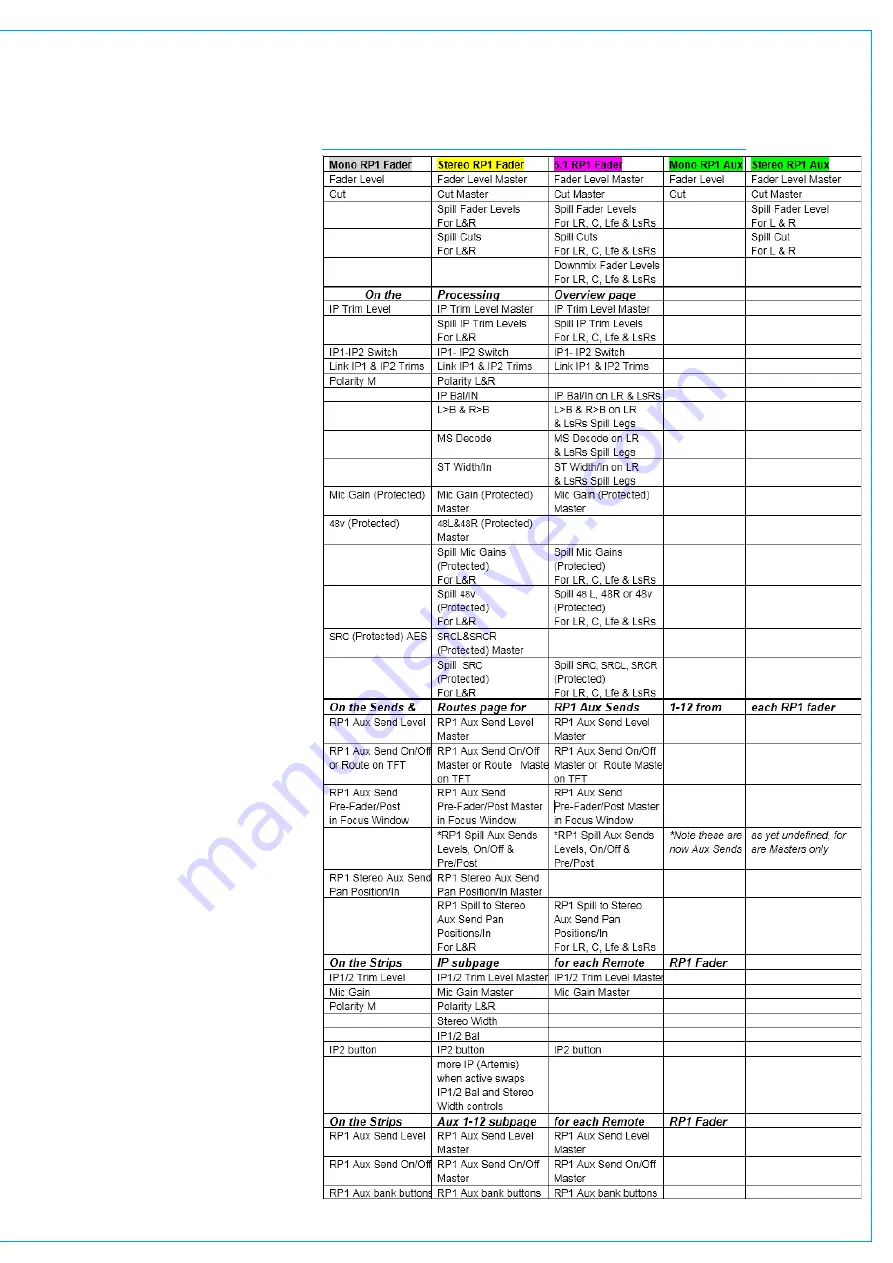
REMOTE PRODUCTION RP1 OPTION
From V8.0 Apollo and Artemis have
the ability to act as ‘Host Consoles’
for the RP1 remote production unit.
The RP1 remote production unit is
designed to be a self-contained compact
mixing console without a control surface.
RP1 gives you the power to manage I/O
and create zero-latency monitor mixes
at venues all over the world, all from the
comfort and familiarity of the Calrec
console at the host production facility
over long distance using IP services.
For an overview of remote production see
the
Guide to remote production (926-253)
downloadable from the Calrec website.
Once the RP1 unit has been setup at the
remote site using a Web browser interface
called “Calrec Assist” it can be accessed
and controlled from the surface of an
Apollo or Artemis console at the host
studio, either as a standalone system or
as part of a Hydra2 network after it has
been added as a ‘Remote Network’ in the
host networks H2O application.
The operation and integration of the RP1
remote production unit with the Apollo
and Artemis console range is the subject
of a separate manual :-
Remote Production RP1 System Manual
(926-222)
downloadable from the Calrec
website. In that manual, is a chapter
called ‘Operation Via Host Console’ which
shows how to setup and operate the RP1
remote production unit via a host console
in this case an Artemis.
FunctionTableforParameter
ControlofRemotePaths
Once the RP1 is connected, the Apollo
and Artemis surfaces currently allow the
user to control a range of functions for
the ‘Remote Faders’ and ‘Remote Aux
Masters’ from the host as shown in Fig 1.
The table is arranged as mono, stereo
& 5.1 remote fader types and mono &
stereo remote aux master types arranged
in columns. Each of the rows across the
table represent a different parameter that
can be controlled from the host console.
In addition to the table, all the controls
that are relevant to the RP1 remote faders
and remote aux masters are available as
wild controls.
FIG 1 - REMOTE PATH PARAMETER CONTROLS FROM HOST
Summary of Contents for Artemis
Page 7: ...calrec com Putting Sound in the Picture ARTEMIS INFORMATION ...
Page 11: ...calrec com Putting Sound in the Picture ARTEMIS INTRODUCTION ...
Page 17: ...calrec com Putting Sound in the Picture ARTEMIS CONTROL OVERVIEW ...
Page 29: ...calrec com Putting Sound in the Picture ARTEMIS CONTROL PANEL MODES ...
Page 36: ...36 ARTEMIS Digital Broadcast Production Console Control Panel Modes WILDABLE CONTROLS ...
Page 39: ...calrec com Putting Sound in the Picture ARTEMIS GETTING SIGNALS INTO ARTEMIS ...
Page 69: ...calrec com Putting Sound in the Picture ARTEMIS PROCESSING AUDIO ...
Page 93: ...calrec com Putting Sound in the Picture ARTEMIS ROUTING AUDIO ...
Page 109: ...calrec com Putting Sound in the Picture ARTEMIS PASSING SIGNALS OUT OF ARTEMIS ...
Page 117: ...calrec com Putting Sound in the Picture ARTEMIS MONITORING ...
Page 132: ...132 ARTEMIS Digital Broadcast Production Console Monitoring ...
Page 133: ...calrec com Putting Sound in the Picture ARTEMIS COMMUNICATIONS ...
Page 138: ...138 ARTEMIS Digital Broadcast Production Console ...
Page 139: ...calrec com Putting Sound in the Picture ARTEMIS METERING ...
Page 148: ...148 ARTEMIS Digital Broadcast Production Console ...
Page 149: ...calrec com Putting Sound in the Picture ARTEMIS SHOWS MEMORIES AND PRESETS ...
Page 163: ...calrec com Putting Sound in the Picture ARTEMIS CONSOLE FACILITIES ...
Page 168: ...168 ARTEMIS Digital Broadcast Production Console ...
Page 169: ...calrec com Putting Sound in the Picture ARTEMIS EXTERNAL INTERFACING ...
Page 180: ...180 ARTEMIS Digital Broadcast Production Console External Interfacing ...
Page 181: ...calrec com Putting Sound in the Picture ARTEMIS SYSTEM STATUS ...
Page 184: ...184 ARTEMIS Digital Broadcast Production Console ...
Page 185: ...calrec com Putting Sound in the Picture ARTEMIS GLOSSARY OF TERMINOLOGY ...
Page 191: ...calrec com Putting Sound in the Picture ARTEMIS FEATURES BY SOFTWARE VERSION ...
















































